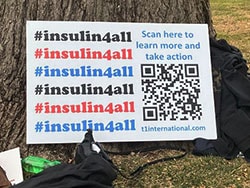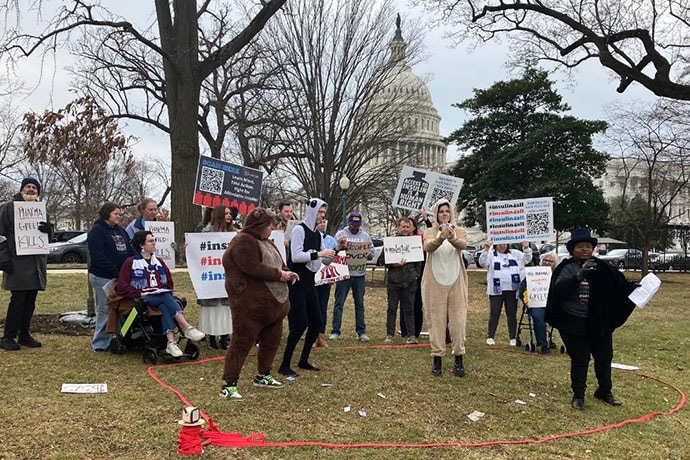Despite Price Caps, Some Still Struggle to Access Insulin
Despite recent legislation capping insulin prices and manufacturer assistance programs, some people with diabetes who require insulin still encounter barriers to obtaining a reliable supply.

Earlier in February 2025, advocates with the organization T1 International performed a three-act play outside the US Capitol building that they titled “Circus of Pharma Greed,” decrying what they say are harmful “price-gouging” practices by the three major insulin manufacturers. The next day they lobbied Congress, sharing a letter signed by more than 8000 individuals calling for legislation that would stop these practices and cap insulin out-of-pocket costs nationwide for all people with diabetes who use it, regardless of insurance status.

“[Insulin affordability] has improved for some people but not for all…And especially with all the different issues with health insurance nowadays and it being tied to employment…The patient choice is eliminated in a lot of insurance plans so they don’t get to choose the insulin that works best for their body. Our goal is not just to liv but to thrive,” Chris Toavs, global advocacy and communications manager at T1 International, told Medscape Medical News.
Reached for comment, the three manufacturers — Novo Nordisk, Eli Lilly and Co, and Sanofi — denied several of the advocacy group’s accusations including that they engage in “monopolistic control, price gouging, and patent manipulation.” Each also sent Medscape Medical News information about their respective patient assistance programs.
Nonetheless, patients with diabetes still often have difficulty affording and otherwise obtaining their insulin for a variety of reasons, Kasia Lipska, MD, endocrinologist at Yale School of Medicine, New Haven, Connecticut, told Medscape Medical News.
“We had legislation, the inflation Reduction Act, which capped the cost of insulin for Medicare beneficiaries. Here in Connecticut, we have a copay cap for people insured through state regulated plans, and the manufacturers have lowered the prices of some of their products. Despite all those things, we still see people having problems accessing affordable insulin…I still see this being a huge issue,” Lipska said.
One major barrier is just navigating the system, both advocates and Lipska noted. “The system is really complex. I see a lot of commercially insured patients who are getting charged much more for insulin than $35 a month. The Inflation Reduction Act just capped it for Medicare but not for commercially insured patients. You would think that commercially insured patients would be charged no more than $35 a month because manufacturers have lowered prices, but because of how formularies are constructed and how people are charged, I see people who are charged more.”
For example, Lipska pointed out that the $35 copay is doubled for patients who take two different types of insulin, including all with type 1 diabetes who use multiple daily injections rather than a pump. And because pharmacies can’t break up boxes containing five insulin pens, patients can also be charged double depending on the amount prescribed.
Lipska, a researcher at the Center for Outcomes Research and Education, Yale-New Haven Hospital, New Haven, Connecticut, led an often-cited study in 2018 finding that 1 in 4 people with diabetes who use insulin reported having to ration it. Her team has recently completed work on a 2024 follow-up survey, which she anticipates will be published soon.
Lipska advised clinicians to continue assessing patients’ ability to afford their insulin. “Keep asking people about their access and affordability of insulin. Don’t assume just because we have these regulations and copay caps for Medicare beneficiaries, and the reduction in insulin prices set by manufacturers that the problem has gone away. I think it’s still really important to have open conversations with patients about their ability to afford medications, including insulin.”
Companies Offer Some Patients Assistance
In the T1 International performance, the big three insulin manufacturers were portrayed by advocates in bear costumes, with Monopoly money and hula hoops among the props. They accused the companies of several deceptive practices including “pay for delay,” where the big three pay smaller companies to stay out of the insulin market, “product hopping,” in which patients are frequently switched to higher-priced alternative brand-name products, and “killer acquisitions,” in which the large companies buy up smaller startups that tried to enter the market with less expensive insulin.
Moreover, the advocates said that patients often encounter barriers, aka “hoops,” using the manufacturers’ coupons, either because they don’t qualify or the insulins covered aren’t the ones that work best for them. They singled out Novo Nordisk for its recent discontinuation of the long-acting Levemir because one narrator said, “they wanted to make more money by manufacturing other drugs.”
Lipska said that switching insulin brands is problematic for some patients, noting, “Novo Nordisk stopped making Levemir which was a very popular type of insulin. Interestingly, it was associated with the least amount of weight gain.”
In response, a Novo Nordisk representative told Medscape Medical News that the December 31, 2024, Levemir discontinuation was first announced in November 2023, with the intent of ensuring “a smooth transition for people using Levemir, their caregivers, and physicians, allowing time to discuss alternative treatment options.”
The decision was not related to the company’s glucagon-like peptide 1 medications as many have assumed, the spokesperson said. But rather, “It was due to a combination of factors, most notably global manufacturing constraints, a ~60% decline in access across Commercial and Part D formulary losses impacting patient access, and the availability of alternative options in the US.”
Novo Nordisk will lower the US list prices for Tresiba and Fiasp by more than 70% starting January 1, 2026, following the lowering of its other insulin products on January 1, 2024. The company offers patient assistance programs through NovoCare, including a program called MyInsulinRx that offers digital savings for patients with commercial insurance or no insurance.
For its part, Eli Lilly told Medscape Medical News that the company hasn’t raised the list prices of its four insulin products in 7 years, and in fact “we’ve only lowered them…and as of 2023 the average monthly out-of-pocket costs for Lilly insulin was just $17.16.”
All Lilly insulins are available for $35 per month through the Lilly Insulin Value Program for people with commercial insurance or who are uninsured. “Our $35 program does not require any application, waiting period, identifying information, or income thresholds,” the Lilly spokesperson said.
Lilly also doesn’t engage in practices that stifle competition, the rep added. “We…support generic and biosimilar competition when patents expire. The patent on Lilly’s most commonly prescribed insulin, Humalog U-100, expired in 2014…and Lilly has filed precisely zero challenges to delay or impede biosimilar competition. We encourage biosimilar competition and launched our own lower-priced biosimilar, Rezvoglar, a biosimilar to, and interchangeable with, a competitor’s basal insulin (Lantus), at a 78% lower price.”
A spokesperson for the third “big three” insulin manufacturer, Sanofi, told Medscape Medical News that the insurance companies and pharmacy benefit managers (PBMs) play a role in insulin affordability. “Under the current system, savings negotiated by health insurance companies and PBMs through rebates are not consistently passed through to patients through lower co-pays or coinsurance. As a result, patients’ out-of-pocket costs continue to rise while — between 2012 and 2023 — the average net price of our insulins declined by 76%.”
Like the other two insulin manufacturers, Sanofi offers several programs that cap the cost of their insulins at ≤ $35 for a 30-day supply for patients regardless of income or insurance status. Sanofi also has ongoing collaborations with Amazon Pharmacy and GoodRx“to expand access and affordability pathways to people who rely on our diabetes medications,” according to the Sanofi rep.
But the advocates said that these patient assistance programs are not long-term solutions nor are price caps. Lipska agreed. “I think price caps are a bandaid solution. In and of themselves, they don’t fix our system. I would like to see bigger system-level changes in terms of how we regulate pricing and access to medications.” As of now, she said, “I think it’s a greedy system.”
Toavs has no disclosures. Lipska received funding from the National Institutes of Health, and UpToDate.
Miriam E. Tucker is a freelance journalist based in the Washington, DC, area. She is a regular contributor to Medscape Medical News, with other work appearing in the Washington Post, NPR’s Shots blog, and Diatribe. She is on X (formerly Twitter) @MiriamETucker and BlueSky @miriametucker.bsky.social.


 Admin_Adham
Admin_Adham


